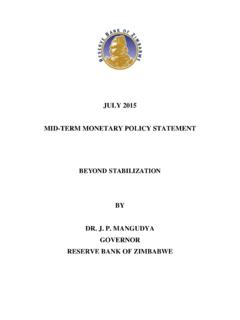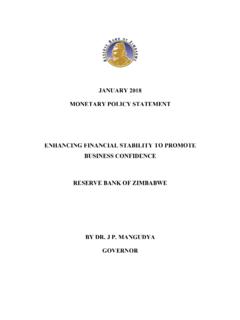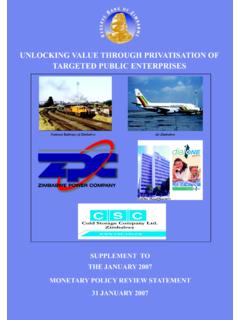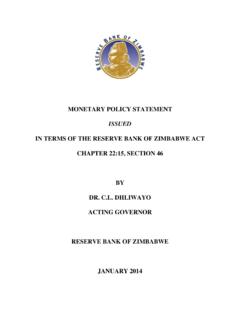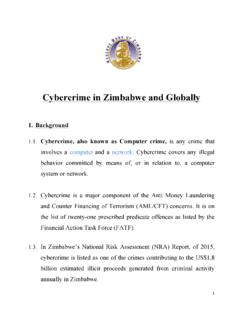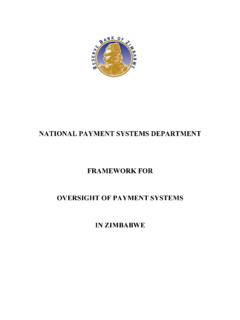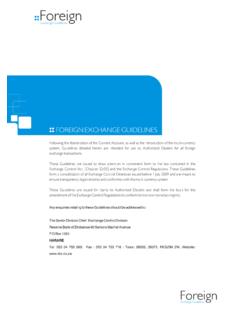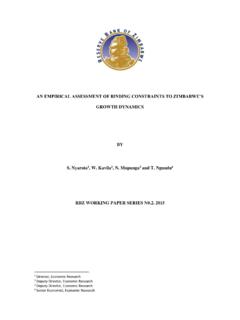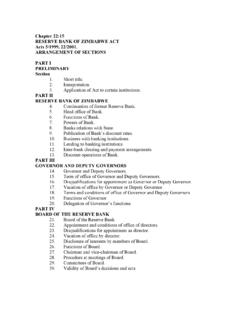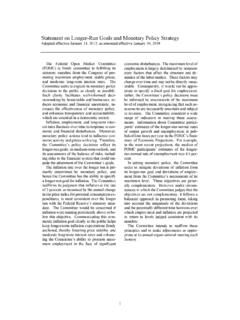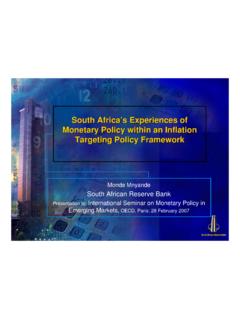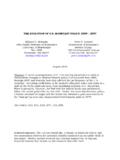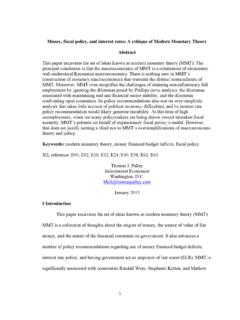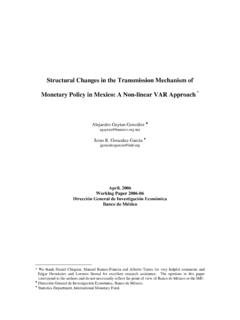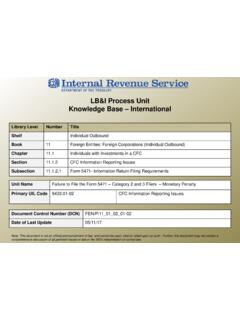Transcription of 2017 MID-TERM MONETARY POLICY STATEMENT …
1 1 2017 MID-TERM MONETARY POLICY STATEMENT PRODUCE AND CREATE RESERVE BANK OF ZIMBABWE 2 August 2017 2 Table of Contents OVERVIEW .. 5 SECTION 1: REVIEW OF PREVIOUS MONETARY POLICY MEASURES ..9 FINANCIAL SECTOR STABILITY .. 13 FOREIGN EXCHANGE MANAGEMENT .. 17 FINANCIAL INCLUSION STRATEGY .. 30 PRODUCTIVE & EMPOWERMENT FINANCING .. 19 NATIONAL PAYMENT SYSTEMS DEVELOPMENTS .. 31 SECTION 2: GLOBAL DEVELOPMENTS .. 26 ZIMBABWE EXTERNAL SECTOR DEVELOPMENTS .. 36 SECTION 3:INFLATION DEVELOPMENTS .. 37 SECTION 4: FINANCIAL SECTOR DEVLOPMENTS .. 37 SECTION 5: MONEY & CAPITAL MARKETS DEVELOPMENTS .. 50 SECTION 6: POLICY MEASURES .. 58 SECTION 7: CONCLUSION .. 70 3 List of Figures Figure 1: Credit Registry Enquiries .. 11 Figure 2: Export Productive & Empowerment Facilities .. 20 Figure 3: Gold Deliveries 2014 June 2017 (kg) .. 21 Figure 4: Comparative of Aggregate Electronic Payments Values for 2016 & 2017.
2 22 Figure 5: Retail Payment Steram Values from July 2016 to June 2017 .. 23 Figure 6: Retail Strem Volumes from July 2016 to June 2017 .. 23 Figure 7: Commodity Price Indices (2010 -100) .. 28 Figure 8: Precious Minerals Prices January 2016 June 2017 (US$/ounce) .. 29 Figure 9: Base Metal Prices (US$/tonne) January 2016 June 2017 .. 30 Figure 10: Annual Inflation Rate .. 33 Figure 11: Developments US$/ZAR Exchange Rate & International Oil Prices .. 35 Figure 12: Crude Oil Prices .. 35 Figure 13: Prudential Liquidity Ratio Trend (%) .. 42 Figure 14: Cross Banking Sector Deposits (30 June 2009-30 June 2017 .. 43 Figure 15: Non-Performing Loans (NPLs) .. 44 Figure 16: Trends in the MFI Sector .. 47 Figure 17: MFIs Distribution of Loans as at 31 March 2017 .. 48 Figure 18: Annual Broab Money Supply Growth Rates & Levels .. 50 Figure 19 Composition Broad Money .. 21 Figure 20: Distribution of Credit by Sector .. 22 Figure 21: Average Monthly RTGS Account Balances.)
3 53 Figure 22: Government Securities by Tenure as at 30 June 2017 .. 54 Figure 23: ZSE Total Market Capitalisation (US$ million)..56 4 List of Tables Table 1 : Global Foreign Currency Receipts .. 14 Table 2: Utilisation of Foreign Currency Receipts .. 15 Table 3: Cumulative Foreign Currency Inflows & Export Incentive Entitlements by Sector 5 May 2016 30 June 2017 .. 16 Table 4: Finacial Inclusion Indicators .. 19 Table 5: Payment Systems Access Points & Deevices as at 30 June 2017 .. 24 Table 6: RTGS Activity January June 2017.. 25 Table 7: Global Economic Growth & Outlook (%) .. 27 Table 8: Balance of Payments Developments (US$ millions) .. 31 Table 9: Annual Inflation Rates for Selected SADC Member Countries & USA (%) .. 36 Table 10: Financial Soundness Indicators .. 38 Table 11: Capitalisation Levels of Banks .. 40 Table 12: Total Loans and Assets in the MFI Sector (Dec 2015 March 2017.)
4 45 Table 13: ZSE Indices as at 30 June 2017 .. 55 Table 14: New Licensing Fees for ADLAS ..68 5 OVERVIEW This MONETARY POLICY STATEMENT is issued in terms of Section 46 of the Reserve Bank of Zimbabwe Act [Chapter 22:15] which requires the Bank to issue a STATEMENT containing an evaluation of the MONETARY POLICY of the last preceding six months and a description of the POLICY measures to be followed by the Bank during the next succeeding six months. The first half of the year 2017 witnessed a turnaround of the national economy at a time when inflation, underpinned by an expansionary fiscal POLICY stance, crept out of deflation in February 2017 after two and a half years of a prolonged episode of negative inflation to reach in June 2017. The economy is thus expected to grow by in 2017 largely driven by agriculture, mining and tourism.
5 Whilst agricultural output is projected to grow by , on account of a combination of favourable rainfall season and the positive financial impact of the Presidential and Command agricultural input programmes, the mining and tourism sectors are on the rebound due to stability in the international commodity prices and price competitiveness, respectively. The favourable agricultural season has a positive spill-over effects on the agro-processing industry. This, together with the revival of around 350 firms in the manufacturing sector that are benefiting under the Government s localisation POLICY which is supported by Statutory Instrument 64 of 2016 has seen the manufacturing sector enhancing capacity utilization. Some firms in the food processing and packaging sub-sectors are now operating at above 70% of capacity. Prioritisation of foreign exchange allocations by the Bank to these firms continues to greatly assist the localization process and enhancing local production and exports.
6 6 It is against this backdrop that the Bank s supply-side funding initiatives to enhance production, productivity and exports were put in place at the beginning of the year. The funding initiatives include the export finance facility, business linkages fund, tourism support facility, cross border facility, gold support facility, women empowerment fund, youth empowerment fund, fund for people with disabilities and the horticulture support facility. These funding programmes together with the export incentive scheme aimed at enhancing export competitiveness have assisted to inculcate export culture as sine qua non for the sustenance of dollarisation/multi-currency system and to enhance production and productivity. Focusing on foreign exchange generation and the production of goods and services is essential, not least because foreign exchange is a critical factor of production especially under dollarisation and when the country is internationally isolated as evidenced by Zimbabwe s limited access to foreign finance.
7 The country needs to produce and create foreign exchange to finance its needs that include fuel, electricity, loan repayments, portfolio investments flows and raw materials for industry. There is no substitute for hard work to generate and enhance the supply of foreign exchange, especially given the country s external position which is already weakened by more than 16 years of economic and financial isolation. We are by ourselves a situation that compels us as Zimbabweans to pull together to be closer together - and focus on nation building, and reducing the power of negativity. Efficient utilisation of foreign exchange therefore becomes essential in a situation in which the demand for foreign exchange is higher than supply, and exacerbated by lack of foreign finance. It is the discrepancy or mismatch between the supply and demand for foreign exchange, in a dollarised Zimbabwean economy, that cause cash shortages and scarcity premiums of between 5 25% in the informal or parallel 7 markets.
8 The scarcity premiums or discounts are thus a symptom of excess demand for foreign exchange. It is therefore not the mediums of exchange dollar cash, bond notes, plastic money or the real time gross settlement (RTGS) that cause premiums in the parallel markets or the multi-pricing system. It is the disequilibrium or mismatch between the domestic quantity of money (local dollars) and the supply of foreign exchange (foreign dollars) that cause cash shortages and, resultantly the scarcity premiums and the multi-pricing system. This means that the market views the intrinsic value of the dollar in Zimbabwe being lower than the foreign dollar. In coming up with solutions to cash shortages, focus should therefore be on the sources of money creation (or supply) and its utilization and not on the mediums of exchange. The lower supply of dollars (foreign dollars) is attributable mainly to limited access to foreign finance, declining foreign investor confidence which has reduced capital flows and the indiscipline-induced leakages of forex through illicit transactions and other nefarious activities that include rent seeking behaviour.
9 The root cause of excess demand for forex, on the other hand, is emanating mainly from increases in money supply as a result of greater spending by Government, money creation loans and overdrafts by banks. It is these external and domestic imperatives or fundamentals that need to be addressed to bring equilibrium and resolve the challenges besetting the economy. Bringing equilibrium or rebalancing the economy therefore requires action to increase the export of goods and services whilst simultaneously reducing fiscal deficit to sustainable levels and executing structural reforms that increase investor confidence and transform the state owned enterprises. These measures are critical to deal with the confidence deficit which is also a major source of gross market indiscipline rent seeking behaviour, corruption, illicit flows, side marketing 8 within the national economy.
10 Whilst the Bank is using a number of initiatives including non-traditional home-grown MONETARY POLICY tools and the export incentive scheme to address export competitiveness to stabilise the economy, the other two imperatives are outside the purview of MONETARY POLICY . Other essential POLICY measures to enhance consumer and business confidence include structural reforms related to the ease and cost of doing business, reorganisation of state owned enterprises, enforcement of law and order and the issuance of bankable 99-year leases. Increasing and diversifying export receipts from the current situation where about 85% of foreign exchange in Zimbabwe comes from five (5) products - tobacco, gold, platinum, chrome and diamonds is also critical. On re-engagement, clearance of the country s external debt arrears to the African Development Bank, World Bank and European Investment Bank remains high on the Bank s agenda, following the clearance of the arrears to the International MONETARY Fund on 20 October 2016.
